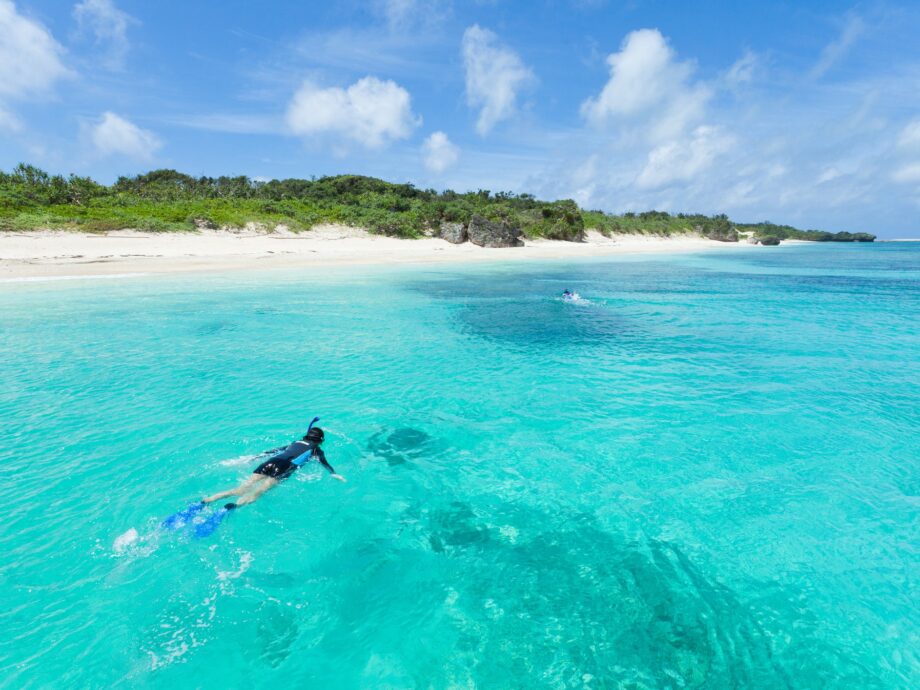Okinawa, where coral seas meet Ryukyu heritage
Warm turquoise seas, a relaxed island tempo, and the living culture of the former Ryukyu Kingdom make Okinawa feel different from the rest of Japan. The prefecture spans more than 160 islands across the subtropical fringe, from the busy gateway of Naha on the main island to far-flung coral atolls near Taiwan. Visitors come for white sand and clear water, then stay for music driven by sanshin lutes, artisan crafts, and a cuisine that blends local traditions with influences from China, Southeast Asia, and the United States.
Daily life can be as active or as unhurried as you want. Start with an onsen soak, join a kayak trip through mangrove forests, and end with a steaming bowl of shabu shabu or a plate of Okinawa soba. Tokyo to Naha is around two and a half hours by air, and boat rides from Tomari Port reach the Kerama Islands, where Kerama Blue water draws snorkelers and divers from across Asia. Most of the best beaches sit away from the industrial port in Naha, clustered on the west coast and in the north of the main island near Onna, Nago, Motobu, and Sesoko.
Okinawa’s official tourism board distills the appeal succinctly. As the team behind Visit Okinawa Japan puts it:
The rich history, culture, and nature of Okinawa’s beautiful islands are ready to be discovered.
The broader travel world has taken notice. Japan recorded more than 36 million visitors in 2024, yet many travelers still skip Okinawa for the big-name cities. Those who do make the hop south find an easygoing alternative, with warm seas for much of the year and fewer crowds outside the summer peak. Landscapes range from dramatic cliffs like Cape Manzamo and Cape Zanpa to shallow lagoons ideal for families. Offshore, divers and snorkelers spot manta rays and sea turtles. Humpback whales breed in nearby waters during winter.
American influence remains visible after World War II, from A&W burger outlets to Blue Seal ice cream and the local favorite of pork and egg onigiri. The Ryukyu roots run deeper, shaping everything from music and dance to pottery and glassware. That blend of heritage and island life, plus a diet rich in vegetables, tofu, and the region’s distinctive seaweeds, is one reason Okinawa is often cited as a Blue Zone for longevity.
When should you visit
Planning around weather is key. Okinawa sits in a humid subtropical zone, with sea breezes and warm water most of the year. The rainy season typically starts earlier than on mainland Japan, beginning in May in Okinawa. Typhoons are most likely from August to September, which can temporarily disrupt ferries and flights. For many travelers, the sweet spots are April to early May and late September through November, when skies are often clear and heat is less intense.
Winter is cooler but still mild by Japanese standards, with daytime temperatures often in the mid to high teens Celsius. It is a great time for whale watching around the Kerama Islands from January to March. The islands even see cherry blossoms weeks before Tokyo, with trees blooming from mid January to early February. Summer brings bath warm seas and buzzing festivals, along with stronger sun and higher humidity. If you go then, build in rest time and plan inland or evening activities.
Festivals add color to any trip. The Naha Dragon Boat Races energize Golden Week in early May. In August, thousands of performers fill the streets for the Eisa dance festival. Autumn brings the Shuri Castle Festival with pageantry inspired by the Ryukyu court, while the Ryukyu Lantern Festival lights up winter nights from December through March.
Getting there and getting around
Naha International Airport links Okinawa to Tokyo, Osaka, Fukuoka, and several Asian hubs. Farther south, Ishigaki and Miyako also have airports, making it easy to pair the main island with outlying archipelagos. High speed ferries from Naha’s Tomari Port serve Tokashiki, Zamami, and Aka in the Kerama group. A longer ferry route connects Kagoshima on Kyushu to the Amami and Okinawa islands for travelers with time and a taste for slow travel.
Once on the ground, renting a car gives the most flexibility. An International Driving Permit is required for most visitors, and reservations can sell out in peak months. Driving is on the left, roads are well maintained, and local drivers are courteous. Taxis are plentiful in Naha and accept cash or cards. Buses exist across the main island, but frequency drops outside cities and in the evening. On Ishigaki, a multiday bus pass can be good value if you do not plan to rent a car.
One practical point catches some visitors by surprise. Many hotel pools and private beaches require tattoos to be fully covered. As a traveler writing for 9Travel explained:
We realised most hotels in Okinawa do not allow visible tattoos in their pools or attached beaches.
Rules vary, and some properties provide stickers or sleeves to cover body art. Public beaches are usually more relaxed, although it never hurts to check signage on arrival. For hot spring baths and traditional public baths, tattoos often remain restricted unless fully covered.
Where the best beaches and water experiences are
Okinawa’s main island offers easy beach days, but island hop and the water turns even clearer. The Kerama Islands deliver classic castaway coves on a day trip. Farther south, the Yaeyama and Miyako islands add powdery beaches and coral gardens in almost surreal shades of blue. If you prefer to stay on the main island, west coast beaches and capes give you plenty to work with.
Main island highlights
In central and northern Okinawa, Onna and Motobu are beach central. Kariyushi Beach in Onna has shallow water and gear rentals for snorkeling and paddleboarding. Cape Manzamo frames an elephant trunk shaped rock and sweeping ocean views. Nearby Cape Zanpa is famous for dramatic cliffs and a 31 meter lighthouse. Families often base near Ocean Expo Park, home to Okinawa Churaumi Aquarium. The aquarium houses Jinta, believed to be the longest living whale shark in captivity, and showcases southern blue manta rays. Emerald Beach sits inside the park, and Sesoko Beach on nearby Sesoko Island is known for soft white sand and gentle surf.
North of Nago, the forested Yanbaru region rounds out ocean days with hiking and river paddling. Mangrove kayaking is popular on the Hija River and in protected estuaries, where guides share wildlife sightings and local ecology.
Kerama Islands day trips
From Naha’s Tomari Port, ferries reach Tokashiki, Zamami, and Aka in under two hours. The nickname Kerama Blue comes to life the moment you step off the boat. Aharen Beach on Tokashiki has a lively stretch of restaurants and rentals, while Tokashiku Beach draws swimmers seeking a quieter cove. Guided snorkel tours add safety and help you find sea turtles in seagrass meadows just offshore. Bring cash for island transport and simple eateries, and watch ferry schedules closely since departures can sell out in summer.
Travel blogger Alyssa Ramos of My Life’s a Movie captured the appeal on her visit:
My favorite activity was a day trip to Tokashiki Island in the Kerama Islands, known for stunning beaches.
Yaeyama and Miyako
Ishigaki anchors the Yaeyama group, with glass bottom boats gliding over Kabira Bay’s emerald water. Swimming is not permitted in the bay to protect the environment, so plan a snorkel trip elsewhere or head out to Iriomote for mangrove kayaking, waterfall hikes, and remote beaches. Hikers aim for Mt. Nosoko for sweeping island views. Nearby Taketomi preserves coral walled lanes and traditional homes, best explored by bicycle after a quick ferry ride from Ishigaki City.
Miyakojima and its satellite islands boast some of the region’s most photogenic water. Locals call it Miyako Blue for good reason. Bridges link Miyako to Ikema, Irabu, and Kurima, which open up a string of beaches and coves. Sunset paddleboarding, easy snorkeling, and beginner friendly dive sites make these islands a favorite for low stress ocean time.
Healthy reefs need careful visitors. A few quick habits help protect them:
- Use mineral based or reef safe sunscreen and apply well before you enter the water.
- Do not stand on coral. Keep fins away from the reef surface.
- Follow local advice on currents, jellyfish seasons, and entry points.
- Take all litter with you. Leave shells and living creatures in the sea.
Culture and history you can feel
Okinawa’s identity flows from centuries as an independent maritime kingdom. The Ryukyu court traded with China and Southeast Asia and developed arts that still thrive, from classical dance to distinct textiles. You can hear the difference in local music and see it in architecture, pottery, and glasswork. Even the local dialects and cuisine set the islands apart from mainland Japan.
In Naha, Shuri Castle symbolizes that past. A 2019 fire destroyed much of the reconstructed main hall complex, but restoration is underway and the grounds remain open. Guides explain royal rituals and the role of the castle in diplomacy. North of Nago, the Nakijin Castle ruins rise above the sea with sweeping vistas. Katsuren Castle on the east side also rewards with ocean views and a sense of the Ryukyu network.
Okinawa World, a cultural theme park, offers a compact journey through local traditions. The Gyokusendo Cave holds one of Japan’s largest collections of stalactites, while a recreated castle town showcases weaving, indigo dyeing, and glassware workshops. Performances of Eisa drumming and dance echo summer festivals. Yomitan’s pottery kilns let you browse rustic bowls and plates fired in ancient style kilns, and many studios welcome short lessons.
Sites tied to World War II invite quiet reflection. The Peace Memorial Museum documents the Battle of Okinawa and its toll on civilians. Hacksaw Ridge overlooks a battlefield immortalized in film. These visits can add context to the American presence you will notice in pockets of the islands today.
The islands are also a crucible for martial arts. Dojos offer introductory sessions in Okinawan karate styles such as Uechi Ryu. On the water, you might find fishermen willing to take you out in a traditional wooden sabani boat, a low slung craft designed to ride swells rather than cut through them.
What to eat and drink
Fresh seafood anchors local menus, yet Okinawa’s most famous flavors often come from the land. Try Okinawa soba with thick wheat noodles in a rich broth, topped with pork belly or ribs. Goya champuru is a stir fry with bitter melon, tofu, pork, and egg that captures the island palate. Agu pork, a heritage breed, stars in shabu shabu and slow braised rafute. Sea grapes, known as umibudo, pop like ocean caviar, while mozuku seaweed appears in vinegar dressings. Peanut rich jimami tofu surprises first timers with its silky texture.
American influence produced odd yet beloved hybrids. Taco rice combines spiced ground beef, lettuce, and cheese over rice. Pork and egg onigiri from small shops like Potama have become cult favorites. On hot days, stop for a scoop of Blue Seal ice cream in flavors such as Ryukyu royal milk tea or Okinawan salt cookies.
CNA Luxury’s reporting highlights several worthwhile stops for traditional fare and fresh seafood across the main island. In the north, sample premium cuts if you seek out famed Ishigaki beef, prized for tender marbling. For drinks, sip Awamori, a rice spirit aged in clay jars and served straight or with water. Tea lovers can hunt down bukubuku cha, a festive brew with a foamy top that dates back to Ryukyu court life. Dessert fans can track down bean to bar treats at Okinawa Cacao or purple sweet potato confections sold everywhere from supermarkets to airport kiosks.
Islands at a glance
Picking where to focus can be the hardest part of planning. Here is a quick way to match islands to interests.
Main island
Best for a first visit, with the widest choice of hotels, restaurants, and activities. Base in Onna or Motobu for beaches and Ocean Expo Park, or stay in Naha for convenience and day trips to Kerama. Expect the most driving here, which is one reason a rental car is helpful.
Kerama Islands
Easy day trips from Naha with dazzling water. Go for snorkeling, sea turtles, and laid back beach time. Overnight stays let you enjoy empty early morning beaches before day trippers arrive.
Miyako Islands
Famous for calm, shallow lagoons and bridge linked islets. Ideal for paddleboarding, family swims, and leisurely drives. Resorts range from full service complexes to small inns on quiet coves.
Yaeyama Islands
Ishigaki is the transport hub and a good base for boat tours. Kabira Bay gives you those postcard greens and blues from a glass bottom boat. For adventure, hop to Iriomote for mangroves and waterfalls, and Taketomi for a preserved village and easy cycling.
Where to stay
Luxury seekers have options up and down the main island. Hoshinoya Okinawa outside Naha blends contemporary design with Okinawan craft and offers nightly performances. Halekulani Okinawa set in Onna delivers serene rooms, multiple pools, and a spa that taps natural hot spring water. Across the bay, Hyatt Regency Seragaki sits on a small island with covered walkways to the main resort. In Chatan near the American base, Hilton Okinawa Chatan Resort and its DoubleTree sister property face the sunset with pools, shops, and restaurants in walking distance. North on Sesoko Island, the Hilton Okinawa Sesoko Resort fronts wide sand and gentle surf.
Travelers chasing value can find it too. Ryukyu Onsen Senagajima Hotel offers a sea view hot spring and large rooms at midrange prices, a good fit before or after flights since it sits by the airport bridge. In Naha, straightforward city hotels like Tissage Hotel deliver clean rooms and easy access to Kokusai Street and the public market. On the islands, simple guesthouses and boutique beach hotels are common. Book early for summer and holidays, and confirm whether a property enforces tattoo cover policies for pools and private beaches.
Location matters. Staying in Naha cuts airport transfer time and puts you near ferry rides to the Kerama group. Staying in Onna, Nago, or Motobu puts you steps from sand and short drives from the aquarium, capes, and north coast hiking.
Sample itineraries
- Three days, main island highlights: Day 1, Naha and Shuri Castle grounds, then an evening stroll on Kokusai Street. Day 2, Onna coast for Blue Cave snorkeling or paddleboarding, then Cape Manzamo at golden hour. Day 3, Ocean Expo Park and Churaumi Aquarium, with a sunset at Cape Zanpa.
- Five days with a Kerama day trip: Follow the three day plan, then add a ferry to Tokashiki for beach time at Aharen or Tokashiku and turtle snorkeling. Use the extra day for Yanbaru mangrove kayaking or the Southeast Botanical Gardens and Yomitan pottery.
- Seven days island combo: Spend three nights on the main island in Onna or Motobu, then fly to Ishigaki or Miyako for three nights. On Ishigaki, ride a glass bottom boat at Kabira, hike Mt. Nosoko, and ferry to Taketomi for cycling. On Miyako, drive the bridges to Irabu and Kurima for beaches and sunset paddling.
Practical tips and etiquette
Good planning keeps things smooth and respectful.
- Car hire and driving: Bring an International Driving Permit and your home license. Book early in summer. Watch for toll roads and stick to speed limits. Parking is usually easy outside Naha.
- Money: Credit cards work in most hotels and larger restaurants. Carry cash for small island shops, rural cafes, and ferries.
- No tipping: Tipping is not customary. Good service is standard.
- Language: English is understood in major hotels and tourist sites. A few Japanese phrases and smiles go a long way.
- Sun and sea safety: Okinawa sun is strong. Reapply sunscreen, hydrate often, and heed jellyfish warnings and flag systems at beaches.
- Weather checks: In summer and early autumn, monitor typhoon forecasts. Flexible plans help if ferries or flights change.
- Tattoos: Pools and hotel beaches may require covers for tattoos. Public beaches are usually fine, yet policies vary.
- Respect the reef: Use reef safe sunscreen, never touch coral, and keep a safe distance from turtles and rays.
- Food notes: Many specialties are seasonal. Follow local menus to try the freshest dishes, from summer mozuku to winter hot pots.
The Bottom Line
- Okinawa blends coral seas and Ryukyu culture across more than 160 islands.
- Best weather windows are April to early May and late September to November.
- Winter brings whale watching and early cherry blossoms with mild temperatures.
- Renting a car makes beach hopping and sightseeing far easier.
- Kerama day trips deliver standout snorkeling in Kerama Blue water.
- Shuri Castle, castle ruins, and WWII sites add depth beyond the beach.
- Signature dishes include Okinawa soba, goya champuru, agu pork, and sea grapes.
- Many hotels ask guests to cover tattoos at pools and private beaches.
- Luxury resorts cluster in Onna, Chatan, and Sesoko, with good value near Naha.
- Reef care and sun safety keep the experience beautiful for the next visitor.




